Chang'e-2 (Lunar-2 Mission of China) / CE-2
Non-EO
CNSA
Exploration
Quick facts
Overview
| Mission type | Non-EO |
| Agency | CNSA |
| Launch date | 01 Oct 2010 |
Chang'e-2 (Lunar-2 Mission of China) / CE-2
Overview Spacecraft Launch Mission Status Sensor Complement References
Chang'e-2 was the second Chinese robotic probe to orbit the moon, a follow-up mission to the Chang'e 1 lunar probe, which was launched in 2007. Chang'e- 2 is part of the first phase of the Chinese Lunar Exploration Program (CLEP), undertaken by CNSA (China National Space Administration). The main goal of Chang'e-2 is to collect high-resolution imagery of possible lunar landing sites of the future Chang'e-3 satellite mission and to test some crucial techniques for the follow-up lunar and deep space explorations of China. The Chang'E-3 is planned to land on the Sinus Iridum landing area in 2013.
Note: Chang'e-2 is also spelled as Chang'E-2 as well as CE-2 (Chang'E-2).
The specific objectives of the Chang'e-2 mission are to demonstrate the following key technologies (Ref. 1):
1) The direct injection of the spacecraft into the lunar-transfer orbit without first settling into an Earth orbit
2) Test of the orbital brake technology and capture by the moon at a location 100 km away (100 km lunar orbit insertion)
3) Test of the technology on a 100 km x 15 km lunar orbit maneuver and orbit measure
4) Capture of high-resolution imagery of the landing area in the Sinus Iridum (Bay of Rainbows, 43°N 31°W), a possible landing site of Chang'e-3.
5) Test of the spacecraft by X-band TT&C measurement system
6) Demonstrate new technology such as: LDPC (Low-density Parity-check Code), high-speed (12 Mbit/s) Lunar-Earth data transmission system, the brand-new landing camera, micro CMOS-camera.
The scientific objectives of Chang'e-2 mission are as follows: improving the performance of payloads on the basis of Chang'e-1, improving the accuracy and precision of the lunar scientific data, deepen the following four types of scientific exploration themes:
• To obtain three-dimensional images of the lunar surface with a spatial resolution < 10 m.
• To explore the composition of lunar surface material
• To observe the Earth-Moon and near-moon space environment.
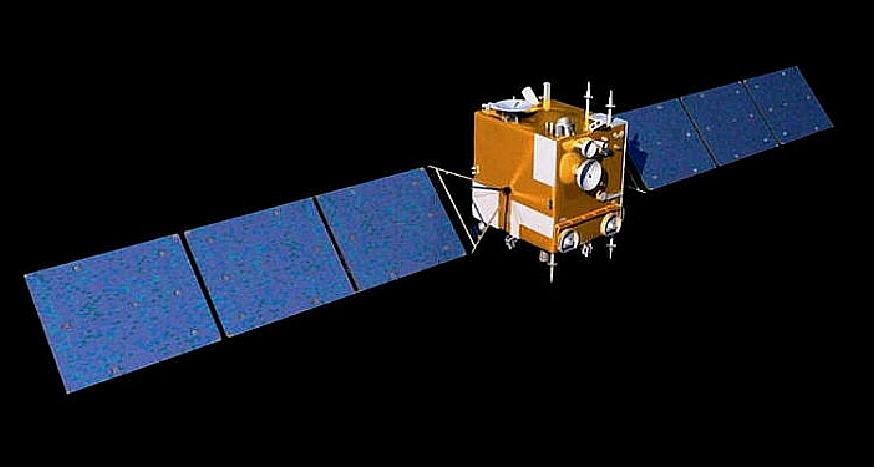
Spacecraft
The Chang'e-2 lunar orbiter is based on the DFH-3 geostationary communication spacecraft bus series of CAST (China Academy of Space Technology). The spacecraft is 3-axis stabilized with a launch mass of about 2480 kg, including 1300 kg of fuel and 140 kg of payload mass. The spacecraft was originally built as a back-up satellite for the Chang'e-1 probe. 1) 2)
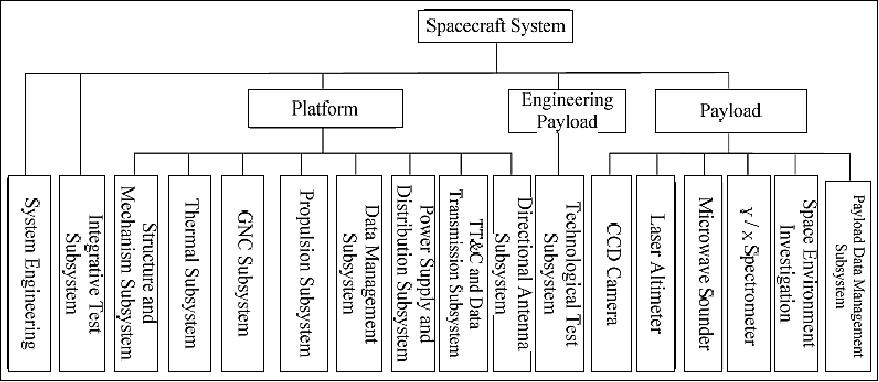
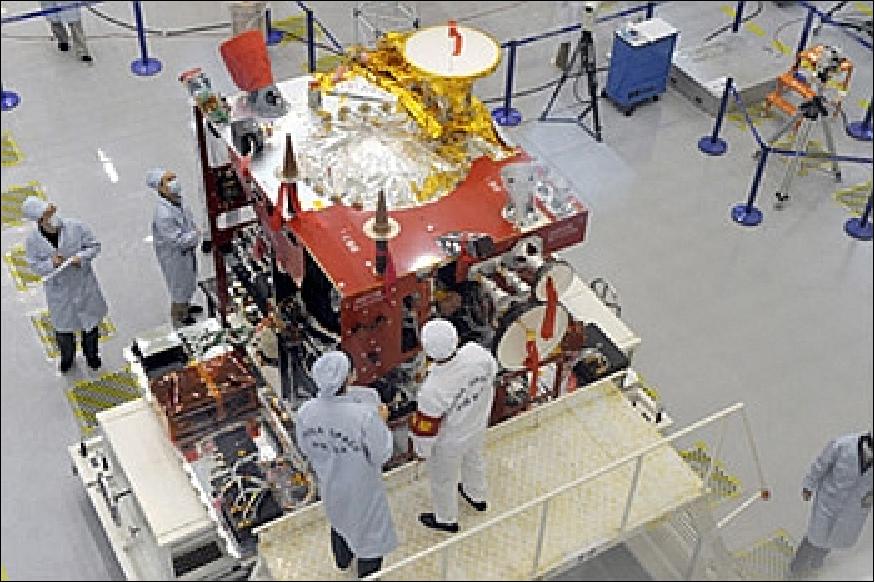
RF communications: Compared with the current S-band TT&C system, the newly established X–band transmission system is more suitable for deep space exploration, which features higher data transfer rate, less signal attenuation, and higher data rates (12 Mbit/s). Data transmission between China's new X-band ground TT&C station and the miniature X-band deep space transponder was demonstrated in the mission.
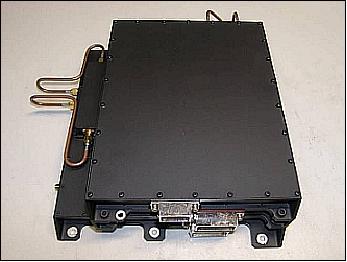
Chang'e-2 is a more capable probe than its predecessor, which underwent numerous technical upgrades for its mission. The probe sports new lunar capture maneuvers, orbit control, an improved high-resolution stereo camera and a new CCD camera – with an increased higher resolution camera compared to Chang'e-1.
Item | Chang'e-1 | Chang'e-2 |
Launch vehicle | LM-3A | LM-3C |
Launch mass | 2350 kg | 2480 kg |
Launch trajectory | S-GTO | Earth-Lunar transfer orbit |
Earth-to-Moon cruise time | 12 days | 5 days |
Lunar working orbit | 200 km x 200 km | 100 km x 100 km |
Spatial resolution | 120 m | 7 m ( 100 km altitude) |
TT&C | S-band | S -band, X-band |
Extended mission | Crash into the Moon surface | Earth-Sun L2 mission |
Spacecraft mass | ≤2480 kg, (dry mass ≤1175 kg) |
Spacecraft size | 2000 mm x 1720 mm x 2200 mm |
Attitude control accuracy, attitude control stability | ≤±1º (3σ), ≤0.005º/s |
Propulsion | Bipropellant propulsion system |
Power | 1466 W (End of life, incident angle 45º) |
TT&C | USB (Unified S-band)+VLBI |
Telemetry code rate | 512 bit/s/1024 bit/s |
Remote control code rate | 125 bit/s |
Coding mode | Convolution coding /LDPC |
Data transmission modulation mode | BPSK |
Data transmission rate | 6 Mbit/s (3 Mbit/s, 1.5 Mbit/s, 750 kbit/s, Testing:12 Mbit/s) |
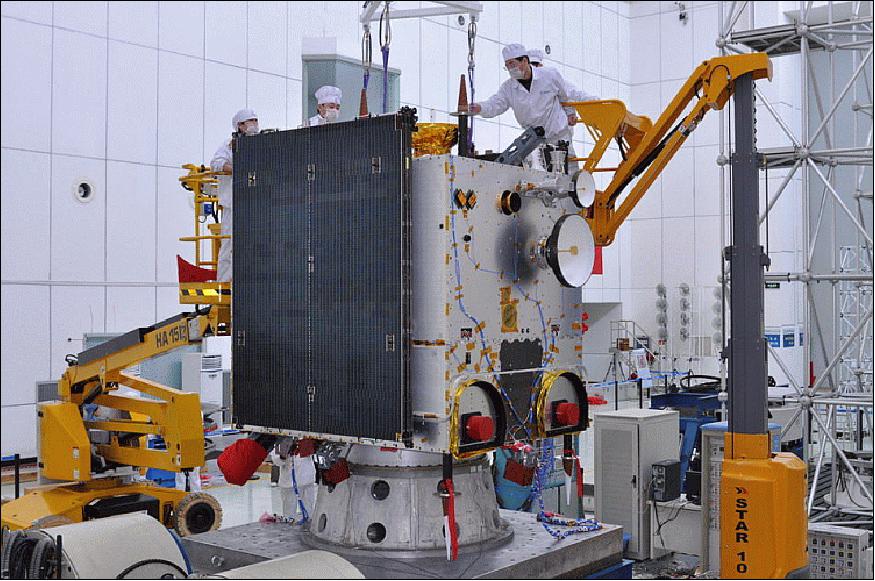
Launch
The Chang'e-2 spacecraft was launched on October 1, 2010 on a CZ-3C (Chang Zheng-3C) vehicle from the LC2 launch complex of XSLC (Xichang Satellite Launch Center) in southwest China.The Probe's launch rocket had two more boosters to accomplish the more direct route to the Moon. 3)
Orbit: The Chang'e-2 was launched directly into an Earth-Moon transfer orbit with a perigee 200 km and an apogee of about 380,000 km. After < 5 days, when the spacecraft was captured by lunar gravity, Chang'e 2 fired its thrusters; the retrofire lasted for 32 minutes and settled the spacecraft into a 12 hour lunar orbit. After three further retrofires, the spacecraft settled into its final orbiting pattern, orbiting at 100 km above the moon's surface once every 118 minutes.
Flight Navigation System: The CE-2 navigation project of the Beijing Aerospace Control Center employed the short baseline interferometry concept for orbit determination. The signal processing method is the kernel of the interferometry technology. The CE-2 lunar satellite downlink signal s establish a short baseline interferometry experiment system. The recorded satellite signals are effectively analyzed. Clear interferometry fringes appear by analyzing the CE-2 lunar satellite signal, and high precision delay and delay rate measurements are obtained. 4) 5)
Compared with a VLBI (Very Long Baseline Interferometry) system,the short baseline DOR (Differential One-way Ranging) interferometry technique has its own advantages:
1) The time synchronization problem between the stations is effectively solved by using the same source of time and frequency.
2) The transmission media errors included troposphere, ionosphere and solar plasma. They are approximately the same between the two tracking stations; thus, the transmission media errors offset each other for the two tracking stations.
In this experiment, the distance between two antennas is about 300 m, that is to say, the baseline length B is about 300 m. Meanwhile, the same high stability frequency source, cesium atomic clock 5585B, is utilized in the two tracking stations, this guarantees strict time synchronization of the two tracking stations.
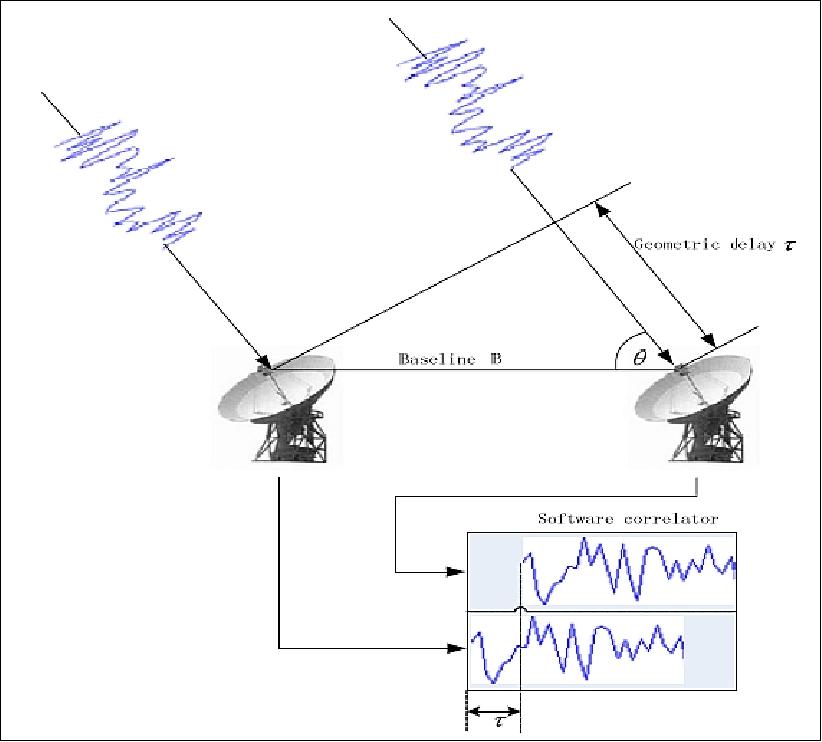
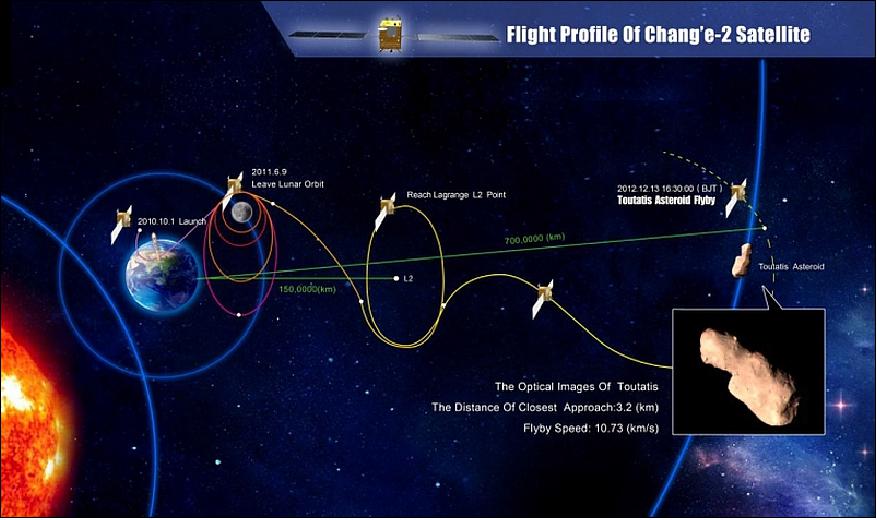
Mission Status
• As of 2015, the Chang'e-2 has reached a distance of over 100 million km from Earth.
• In June 2014, the Chang'e-2 Probe is more than 90 million km away from the Earth, and is expected to fly back to a position 7 million km from the Earth in 2029. 6)
• On July 14, 2013, the Chang'e-2 Probe had reached a distance of 50 million km from Earth, marking a new height in the nation's deep space exploration. The various extended missions of Chang'e-2 have the goal to test China's spacecraft tracking and control network, including two newly built measuring and control stations in the northwest Xinjiang Uygur Autonomous Region and northeast Heilongjiang province. The Probe is still in good condition and on a trajectory leading still further out into the deep space direction. 7)
Scientific data and achievements (Ref. 2):
Chang'e-2 is equipped with 5 scientific payloads, including imaging, detecting of the Gamma-ray spectrum, solar wind ion detection, high energy practices, and so on. Chang'e-2 obtained about 6 TB of raw data, including high resolution overall moon images, local images of the Moon's Sinus Iridium region and Earth-Moon environmental data. - According to the data distribution policy of the Chinese Lunar Exploration Program, the scientific data have been distributed to Chinese universities and academy institutes, including the ones in Hongkong and Macao, which will booster China's moon and space scientific data analysis. Several scientific achievements resulted from the Chang'e-2 mission, including an overall moon image with 7 m resolution (Figure 8) and a distribution map of multiple elements on the moon's surface (Figures 9 and 10). By analysis of the data, scientists will obtain a better understanding of the Moon and of space science in general.
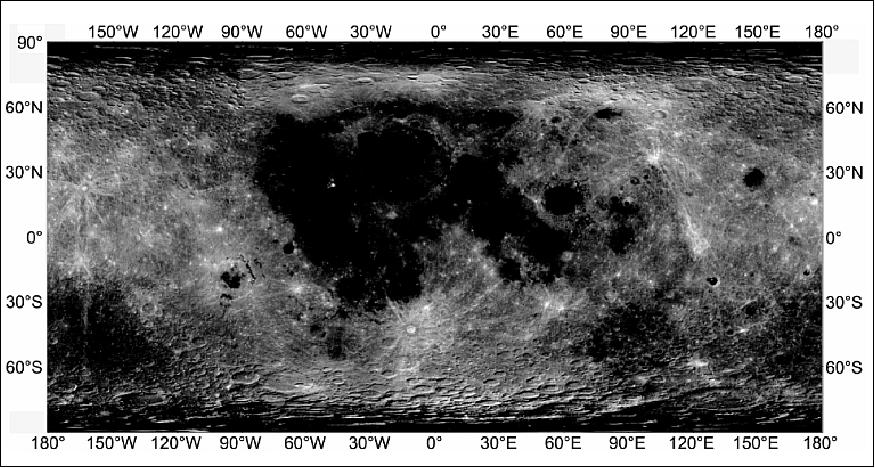
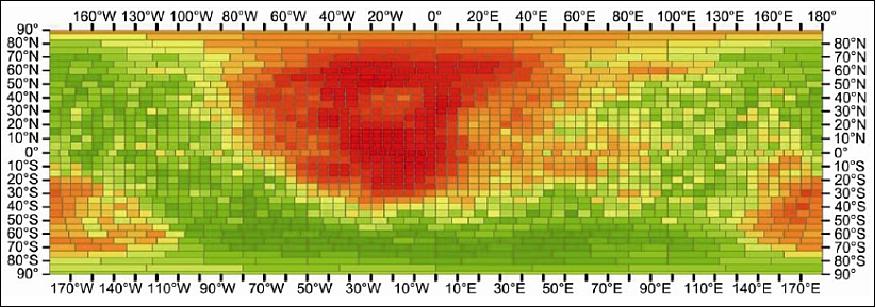
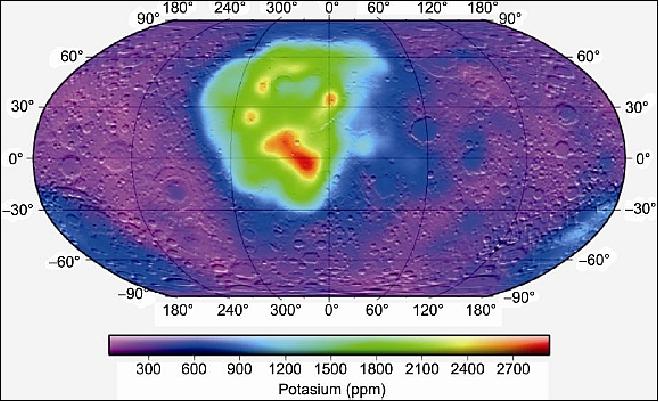
1) Chang'e-2 demonstrated all orbit and maneuvering flight control technologies before powered decent phase of the following landing mission, making breakthrough of direct transfer technology for Earth-Moon orbit flight.
2) Chang'e-2 achieved breakthroughs of some key technologies which applied to the non-uniform gravity field of the moon and uneven surface environment, such as the quasi-frozen orbit design, probe autonomous inertia alignment, maneuvering orbit patching; it also realized a 100 km circle orbit and a 100 km x 15 km elliptical orbit and maneuvering for the first time.
3) Chang'e-2 designed two kinds of compensation methods for the velocity-height ratio by TDI imaging technology, including ground-based input of horizontal frequency data and altimetry data supplementary on board, which solved the problems of high precision determination for real time orbit and integral parameter matching; it also obtained the whole moon stereoscopic images with 7 m resolution, and partial images with 1.3 m resolution.
4) The Chang'e-2 project developed and applied high sensitive digital transponder X-band technology based on a uniform carrier system; it also demonstrated the use of X-band deep space TT&C system and technology. This represents an advancement of China's TT&C system from S-band to X-band system for higher transmission rates; it established the foundation for future deep space exploration missions.
5) Chang'e-2 achieved technological breakthroughs in the implementation of the micro-miniature design technology. For the first time , the probe realized monitoring and imaging of the Earth-Moon cruise phase, obtained real-time dynamic images of some critical process, such as the solar array deployment, antenna deployment/rotating, main engine ignition and so on, by making the critical flight events visible to the project.
6) Chang'e-2 carried out long-life technology demonstrations of the high pressure gas line of the propulsion system, providing the foundation for highly intensive orbit maneuvering (a time span of more than 2 years during which more than 10 orbit maneuvers were conducted) and follow-up L2 Sun-Earth Lagrangian point and asteroid exploration.
7) Under the multi-body environment of the Sun, Earth, Moon and the spacecraft, and facing the perturbation difficulties of the Sun-Earth gravity libration point, no analytical solution for the orbit design, the long distance of TT&C, Chang'e-2 solved the nonlinear system manifold design, low energy transfer orbit control technology , realized the orbit design and flight control of the Moon-L2 flight. For the first time in the world, Chang'e-2 realized the exploration from the Moon to the L2 point, conducted some monitoring of Earth's distant magnetotail ion energy spectrum, solar flare bursts and cosmic Gamma bursts, which made China the third country in the world , after the US and Europe, to conduct L2 point exploration.
8) Chang'e-2 made a breakthrough of the 40,000,000 km deep space flight and TT&C communication technology. Based on the strict constraints of energy, distance, time and the target's physical characteristics, the selection strategy of the potential asteroid was put forward, while approaching flyby exploration and staring imaging technology of gradually-far-point, based on the high velocity rendezvous were put forward and realized. It was the first time in the world to realize the 4179 Toutatis asteroid approaching flyby, and obtain the colorful images with 3 m resolution. In addition to 1 km-level asteroid flyby, China also became the fourth country in the world, following the US, Europe and Japan, to conduct asteroid exploration.
9) By taking advantage of the Lagrangian point feature, an asteroid flyby from Lagrangian point was firstly realized under the constraints of the propellant of the probe, the distance for spacecraft-Earth communication, and the points in time of building a schedule for ground-based antenna and rendezvous for the asteroid, and so on.
10) Based on the innovative design, overall demonstration, elaborate implementation, usage of residual propellant, Chang'e-2 explored the Moon, the L2 point of the Sun-Earth system, and then Toutatis asteroids, realizing the exploration of multiple objectives and multiple missions, while achieving the purpose of ‘faster, better, cheaper', which was far beyond the expectations of the project.
The successes of Chang'e-2 have advanced China's space technology development and promoted the capability of China's spacecraft, with all the specifications of the orbit measurement accuracy, control precision, thermal environment adaption, flight control autonomy, increased image resolution, the technology capabilities such as direct Earth-Moon transfer, X-band TT&C communication, deep space orbit and mission design, autonomous control and more integrated products have been greatly enhanced, gathering experience for China's future deep space exploration program.
• On December 13, 2012, the Chang'e-2 space probe had completed a close flyby of Asteroid Toutatis acquiring close-up images of the asteroid and using its instruments to acquire scientific data. The asteroid has a size of ~ 5 km in length. 8)
At a distance of 240 to 93 km, Chang'e-2 took a set of images with a maximum resolution of 10 m per pixel. The image resolution is not better than the radar maps, but with color images of the asteroid, scientists can better determine albedo properties and use the photos to better understand data acquired with radars.
Only four of the world's space efforts have managed close encounters with asteroids: NASA with NEAR/ Shoemaker and Dawn, the ESA with Rosetta, JAXA with Hayabusa — and now China with Change-2.
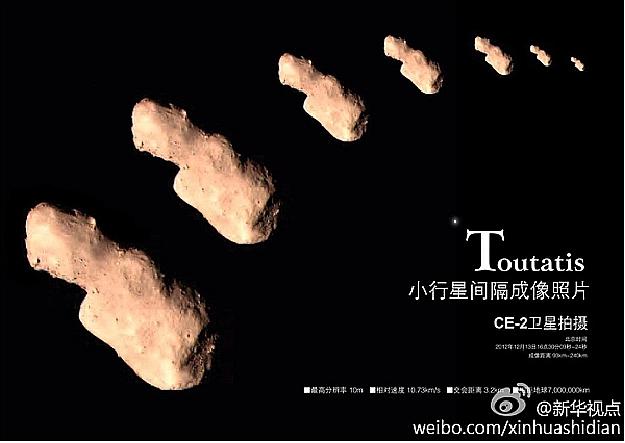
• In the fall of 2012, the Chang'e-2 spacecraft is an operational mission at the Sun-Earth Lagrangian Point L2, operating in a Lissajous orbit. 9)
• Deep space mission: Chang'e-2 Probe departed from L2 on April 15, 2012, and is now heading for a deep space mission. The objective is to obtain important technical data to be used for the implementation of China's future deep-space exploration, regarding such aspects as trajectory design, deep space tracking, and telecommunication (Ref. 1).
• On Feb. 6, 2012, China's space agency released an amazingly detailed map of the moon' surface, made up of many high-resolution images observed by the Stereo Camera of the Chang'e-2 spacecraft during a seven month period between October 2010 and May 2011. 10) 11)
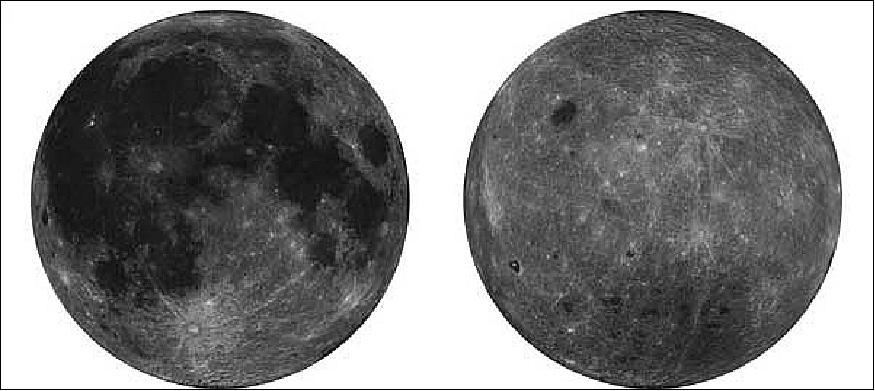
• On August 25, 2011, the Probe reached Sun-Earth Lagrange Point L2 after a 77-day cruise, becoming the first object ever to reach the L2 point directly from lunar orbit, and travelling further than any previous Chinese space probe. It is expected to remain there until the end of 2012, according to the State Administration of Science, Technology and Industry for National Defence (SASTIND). 12)
- In September 2011, Chang'e-2 transmitted the first data observed while orbiting the L2 in a Lissajous trajectory. The data sent back was observed by GRS (Gamma-Ray Spectrometer), HSPD (High-energy Solar Particle Detector), and SWID (Solar Wind Ion Detector), part of the orbiter's payload while it traveled from the moon's orbit to its current position. 13) 14)
- This was the first time for China's spacecraft to fly beyond the moon. It was also an initiative in the international area to explore multiple targets starting from the Earth to the moon, and then to the L2 point and further to the asteroids (Ref. 2).
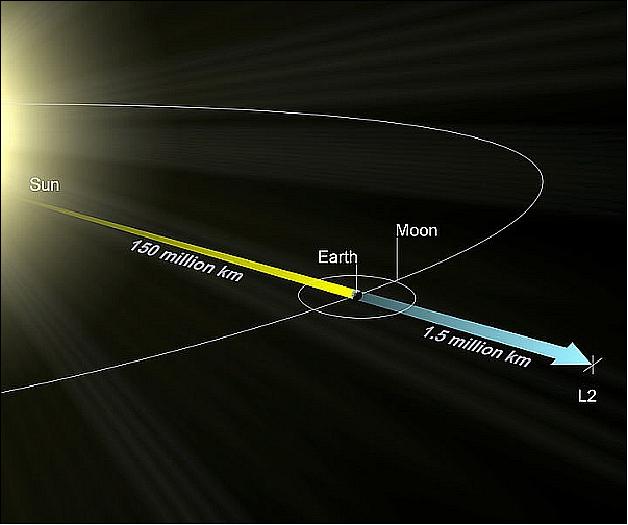
• End of lunar mission: On June 8, 2011, Chang'e-2 completed its extended mission, and left its lunar orbit for the Sun-Earth Lagrangian point L2 (a stable gravity point on the side of the Earth opposite the sun), to test the Chinese tracking and control network. Before flying away, the orbiter had finished two additional tasks as of May 23, 2011: 16)
- One was to take photos of the northern and southern poles of the moon.
- The other was to descend again to the perilune orbit, about 15 km away from the surface, to catch high-resolution images of the Sinus Iridium, or Bay of Rainbows, the proposed landing ground for future moon missions.
• By May 23, 2011, 2011, CE-2 has obtained the entire coverage of the lunar surface, and is now continuing to work in orbit for an extended mission phase.
• By April 2011, the Chang'e-2 mission had reached the end of its half-year design life and achieved all of its scheduled engineering and scientific goals. Hence, the project decided to take full advantage of the remaining propellant and the operational payload and further expand lunar and deep-space exploration. 17)
- During the 150-day nominal lunar mission, Chang'e-2 experienced twice attitude transition for improvement the sun-tracking of the probe's cell panel, three times orbit maintenance and one eclipse control. In accordance with the scientific plan, Chang'e-2 finished each scientific exploration mission, including the whole lunar surface high-precision imaging (Ref. 2).
- At the end of its 6 month mission, Chang'e-2 had 520 kg of propellant left. At the same time, the probe was in good condition. According to the ideas of "improving capability more quickly and promoting technological development", in order to verify the further interplanetary exploration technology and accumulate deep space exploration engineering experiences, Chang'e-2 continued to carry out extended tasks. This was a great opportunity to explore further goals. Hence, a three-phase and multi-target mission was designed. The Sun-Earth L2 point and near-Earth asteroids were selected as the route and direction of the extended missions. The basic purpose was to go further into interplanetary space (Ref. 2).
• On November 2, 2010, the VLBI system along with the USB (Unified S-band ) range and Doppler system, completed the tracking task of the real-time phase of the CE-2 satellite. 18)
- Also on Nov. 2, 2010, Chang'e-2 started the long-term mission operations of the 150-day circumlunar flight (Ref. 2).
• On Oct. 26, 2010, the Chang'e-2 probe was maneuvered into an elliptical lunar orbit of 100 km x 15 km (apoapsis x periapsis) which was maintained throughout the mission. This orbit enabled the cameras to obtain higher-resolution imagery of the lunar surface.
• On Oct. 9, 2010, the Chang'e-2 spacecraft reached its preliminary circular lunar orbit of 100 km x 100 km.
• Lunar orbit insertion of the Chang'e-2 spacecraft from Oct. 6-9, 2010. The probe implemented a total of three times braking at perilune and one time orbital plane maneuver.
• On October 2, 2010, the first midway correction control was implemented. The 490 N engine fired for 70 s. The speed increment was 16 m/s. The control result was accurate and met the requirement of inserting the probe into lunar mission orbit, so the scheduled twice midway orbit corrections were cancelled.
Sensor Complement
The Chang'e-2 project shares similar goals with Chang'e-1: Obtaining three-dimensional images of the lunar surface, analyzing and mapping the chemical elements on the lunar surface, and probing the features of the lunar soil and the space environment near the moon will all be undertaken.
The sensor complement has a mass of ≤140 kg and a power consumption of ≤200 W.
Spacecraft | Instrument | Science target |
CE-1, CE-2 | Stereo camera (CCD) | Obtain three-dimensional stereo image of the lunar surface |
CE-1, CE-2 | LAM (Laser Altimeter, Moon) | |
CE-1 | IIM (Imaging Interferometer Spectrometer) |
|
CE-1, CE-2 | GRS (Gamma-Ray Spectrometer) | |
CE-1, CE-2 | XRS (X-Ray Spectrometer) | |
CE-1, CE-2 | MRM (Microwave Radiometer, Moon) | Explore the lunar soil properties |
CE-1, CE-2 | HPD (High-energy Particle Detector) | Probe the near-moon space environment |
CE-1, CE-2 | SWID (Solar Wind Ion Detector) |
Most instruments are described in the file of Chang'e-1.
Stereo Camera
The CCD stereo pushbroom camera is one of the key payloads carried by the Chang'e-2 satellite, whose mission is to image the lunar surface with high spatial resolution and provide scientific guiding data for choosing a safety-landing site for Chang'e-3. The improved stereo camera design features the TDI (Time Delay Integration) method to increase the detection sensitivity of the instrument. 20)
The CE-2 CCD stereo camera adopts a stereo imaging solution with the single lens and two angles of view in the same track and a pushbroom imaging mode with a high sensitivity TDI capability. Compared with the three-line array mode of the CE-1 stereo camera, CE-2 adopts a two-line pushbroom scheme to reduce the data volume of the imagery. The two-line array CCD stereo camera acquires forward and backward high-resolution imagery of the lunar surface. 21)
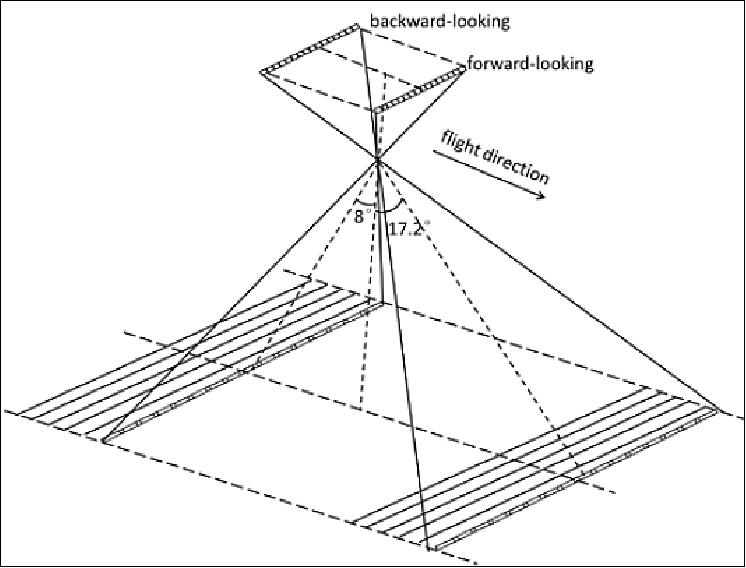
Parameter / Orbit | 100 km x 100 km circular orbit | 100 km x 15 km elliptical orbit |
Nominal swath | 43 km | 6.45 km |
Nominal resolution | 7 m | 1.05 m |
Viewing angle | Forward +8º | backward -17.2º |
Chang'E-2 stereo camera has obtained data of both 7 m (coverage 100%) and 1.5 m (coverage 71%) resolution for the landing area of Chang'e-3. 22)
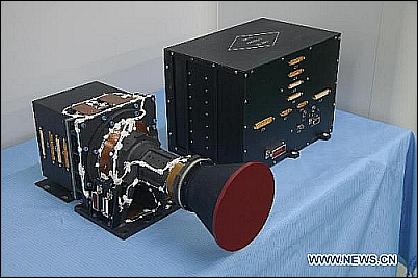
Micro-CMOS Cameras
The Chang'e-2 spacecraft features one landing camera and three surveillance cameras. These cameras feature a smart and low mass, low power, and a highly-integrated camera design. Technologies like auto-exposure, high-speed compression of color imagery and static gray image, and sub-sampling methods are introduced.
The four cameras have taken satisfying imagery of the moon's physiognomy, deployment of satellite solar battery wing, the working state of the 490 N engine, and the deployment of the directional antenna.

References
1) Jiangchuan Huang , Wei Rao, Linzhi Meng, Hao Huang, "Research and Development of Chang'e-2 Satellite," Proceedings of the 63rd IAC (International Astronautical Congress), Naples, Italy, Oct. 1-5, 2012, paper: IAC-12-A3.2A.5
2) Jiangchuan Huang, Linzhi Meng, Wei Rao, Hao Huang, "The Technical Characteristic and Fruition of Chang'e-2 Mission," Proceedings of the 64th International Astronautical Congress (IAC 2013), Beijing, China, Sept. 23-27, 2013, paper: IAC-13-A3.2B.2
3) "Long March 3C successfully launches Chang'e-2, China's second lunar probe," NASA, Oct. 1, 2010, URL: http://www.nasaspaceflight.com/2010/10/live-long-march-3c-launch-change-2-probe/
4) Lue Chen, Geshi Tang, Fei Fan, Lei Liu, Li Li, Mei Wang, Huicui Liu, Songtao Han, Jianfeng Cao, "China's CE-2 Lunar Satellite Experiment Based on Short Baseline Interferometry," Proceedings of IAC 2011 (62nd International Astronautical Congress), Cape Town, South Africa, Oct. 3-7, 2011, IAC-11- B2.6.4
5) Lue Chen, Geshi Tang, Songtao Han, Mei Wang, Fei Fan, "Processing Method and Verification of Local Correlation for Spacecraft DOR Signals," Proceedings of the CSNC (China Satellite Navigation Conference), Guanzhou, China, May 15-19, 2012
6) "Chinese Lunar Exploration Program," China National Space Administration, June 20, 2014, UNOOSA, URL: http://www.unoosa.org/pdf/pres/copuos2014/tech-06.pdf
7) "Chinese probe reaches record height in space travel," Space Daily, July 16, 2013, URL: http://www.spacedaily.com/reports/Chinese_probe_reaches_record_height_in_space_travel_999.html
8) "Chinese Spacecraft makes close Flyby of Asteroid Toutatis," Spaceflight 101, Dec. 15, 2012, URL: http://www.spaceflight101.com/change-2-toutatis-flyby.html
9) Hao Huang, Wenyan Zhou, Linzhi Meng, Wei Rao, Jiangchuan Huang, "Chang'e-2 Satellite Lagrange L2 Point Mission," Proceedings of the 63rd IAC (International Astronautical Congress), Naples, Italy, Oct. 1-5, 2012, paper: IAC-12. A3.2B.6
10) "China publishes high-resolution full moon map," Feb. 6, 2012, URL: http://news.xinhuanet.com/english/sci/2012-02/06/c_131393210.htm
11) Tariq Malik, "China Unveils Best Moon Map Yet from Lunar Orbiter," Feb. 10, 2012, URL: http://www.space.com/14536-china-moon-map-change-2-images.html
12) "Chang'e-2 moon orbiter travels around L2 in outer space," CNTV, Aug. 30, 2011, URL: http://english.cntv.cn/20110830/111695.shtml
13) "Chang'e-2 sends data back from L2," Space Daily, Sept. 23, 2011, URL: http://www.spacedaily.com/reports/Change_2_sends_data_back_from_L2_999.html
14) Hao Huang, Wenyan Zhou, Linzhi Meng, Wei Rao, Jiangchuan Huang, "Chang'e-2 Satellite Lagrange L2 Point Mission," Proceedings of the 22nd Congress of ISPRS (International Society of Photogrammetry and Remote Sensing), Melbourne, Australia, Aug. 25 - Sept. 1, 2012, paper: IAC-12. A3.2B.6, URL: http://images.spaceref.com/news/2012/chang%27e-moon-iac2012.pdf
15) "Chang'e-2 moon orbiter reaches L2 point," NASA, URL: http://lunarscience.nasa.gov/articles
/change-2-moon-orbiter-reaches-l2-point/
16) "China's second moon orbiter Chang'e-2 goes to outer space," Space Daily, June 10, 2011, URL: http://www.spacedaily.com/reports/China_second_moon_orbiter_Change_2_goes_to_outer_space_999.html
17) Wei Ren Wu, Yong Liu, Lei Liu, JianLiang Zhou, GeShi Tang, Yong Zhi Chen, "Pre-LOI trajectory maneuvers of the CHANG'E-2 libration point mission," Science China, Vol. 55 No. 6, June 2012, pp. 1249–1258, URL: http://info.scichina.com:8083/sciFe/EN/article
/downloadArticleFile.do?attachType=PDF&id=507363
18) JinLing Li, Li Liu, WeiMin Zheng, ZhongMiao Sun, "Positioning reduction in the real-time phase of Chang'E-2 satellite," Science China Physics, Mechanics & Astronomy, Vol.55 No.2,Feb. 2012, pp: 371–374, URL: http://www.springerlink.com/content/t1un51638617312k/fulltext.pdf
19) W. Zuo, Z.-B. Zhang, X.-Q. Wang, L. Geng, X. Xiao, J.-Z. Liu, J.-J. Liu, X. Tan, X. Ren, L.-Y. Zhang, X.-D. Wang), J.–Q. Feng, L.-L. Mu, G.-L. Zhang, C.-L. Li, "Public Data Release of the Chinese Chang'E Missions," EPSC-DPS Joint Meeting 2011, Vol. 6, EPSC-DPS2011-995-1, 2011, URL: http://meetingorganizer.copernicus.org/EPSC-DPS2011/EPSC-DPS2011-995-1.pdf
20) Bin Xue, BaoChang Zhao, JianFeng Yang, Wei Gao, WeiDong Qiao, XiaoLong Ma, Bo Zhang, JiaHang Liu, Wei Zhao, JuanJuan Jing, "Auto-compensation of velocity-height ratio for Chang'E-2 satellite CCD stereo camera," Science China Technological Sciences, Vol.54, No.9, 2011, pp. 2243–2246
21) Kaichang Di, Yiliang Liu, Bin Liu, Man Peng, "Rigorous photogrammetric processing of Chang'e-1 and Chang'e-2 stereo imagery for lunar topographic mapping," Proceedings of the 22nd Congress of ISPRS (International Society of Photogrammetry and Remote Sensing), Melbourne, Australia, Aug. 25 - Sept. 1, 2012, URL: http://www.int-arch-photogramm-remote-sens-spatial-inf-sci.net
/XXXIX-B4/307/2012/isprsarchives-XXXIX-B4-307-2012.pdf
22) X. D. Zou, J. J. Liu, L. L. Mou, X. Ren, K. Li, J. J. Zhao, Y. X. Liu, C. L. Li, "Topographic Analysis of the Proposed Landing Area of Sinus Iridum," European Planetary Science Congress 2012, Vol. 7 EPSC2012-151-1, 2012, URL: http://meetingorganizer.copernicus.org/EPSC2012/EPSC2012-151-1.pdf
The information compiled and edited in this article was provided by Herbert J. Kramer from his documentation of: "Observation of the Earth and Its Environment: Survey of Missions and Sensors" (Springer Verlag) as well as many other sources after the publication of the 4th edition in 2002. - Comments and corrections to this article are always welcome for further updates (eoportal@symbios.space).
Overview Spacecraft Launch Mission Status Sensor Complement References Back to top